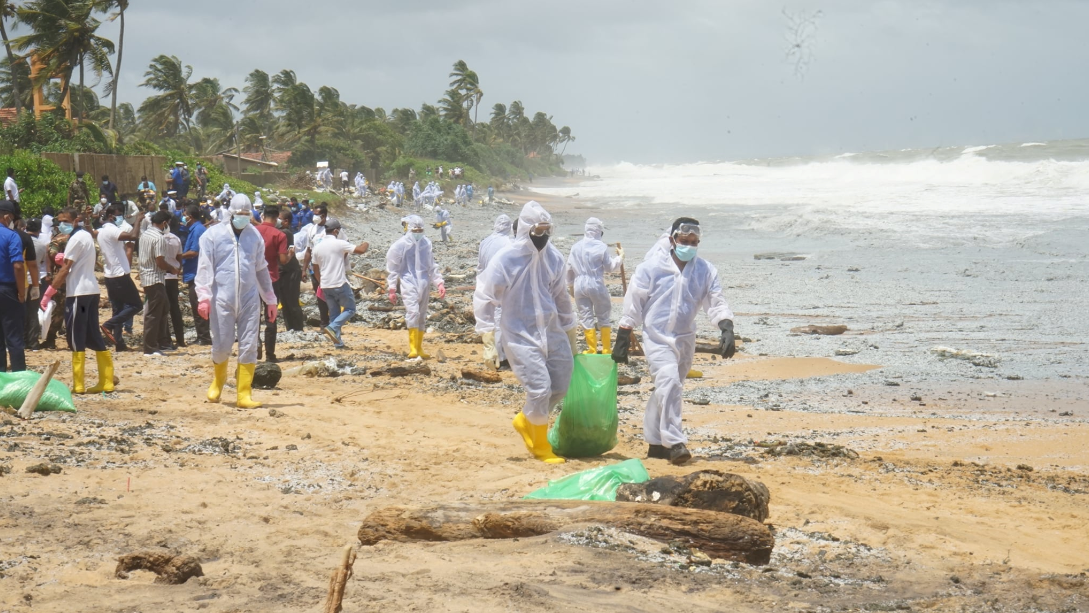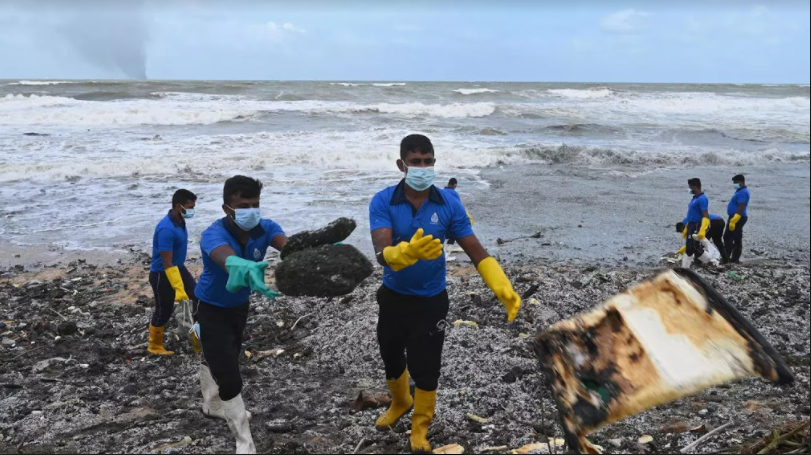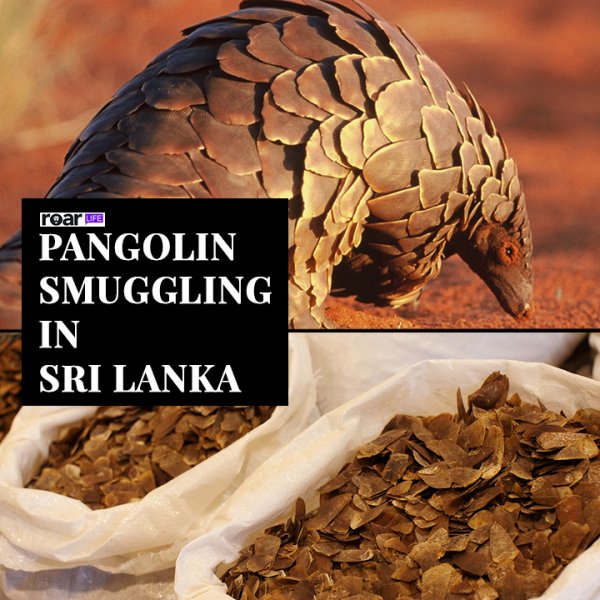
It has been more than a month since the first alarming images of fires burning on board the ill-fated container carrier MV X-Press Pearl were released. With much of the cargo now burnt or fallen into the sea, and a large swathe of the western, southern and northwestern coastline polluted as a result, authorities are working to assess the full extent of the damage.
On 26 May, local headlines warned that Sri Lanka was bracing for a potential oil spill. Desperate efforts to tow the sinking ship to deeper waters were abandoned when the ship’s stern hit the sea bottom. The battle to save MV X-Press Pearl is now lost. This was Sri Lanka’s worst maritime disaster, but comes less than a year since authorities faced a similar situation with another distressed vessel, the MT New Diamond.
The tragic aftermath in both cases, and reports of similar incidents from elsewhere in the recent past, should be more than enough to spur authorities into working towards better preparedness to face potential maritime disasters. With the projections of increased traffic along the island’s sea lanes in the coming years, the importance of paying closer attention to maritime safety becomes more relevant than ever before.

Disasters At Sea
According to Dr Dan Gunasekera, a distinguished academic and a highly experienced professional in the fields of international law, law of the sea and maritime law, Sri Lanka needs to rethink its policies and legislation in order to develop an effective balance between the marine environment and economic development, with a view to ensure protection of the seas around the island.
Dr Gunasekera, who has conducted extensive research on global marine protected areas and merchant shipping, in a 2017 study says, “it is imperative for coastal states, [such as Sri Lanka], to formulate a clear strategy focused on effective protection of marine environment as its primary goal in both its law and policies relating to marine environmental protection and vessel traffic management while respecting freedom of the seas and doctrine of innocent passage.”
Meanwhile, records show a number of serious global maritime accidents in the last five years, resulting in fires, loss of life, and oil spills.
In August 2018, the large crude oil carrier Desh Vaibhav exploded in the Persian Gulf. The Panama-registered Very Large Crude Carrier (VLCC), Sanchi, met its end on 9 January 2018 in the East China Sea, along with its entire crew of 32. Yet another Panama-registered VLCC, Zoya1, caught fire 21 miles off the UAE coast on 29 January 2020.
The threat may not only be from tankers. In 2017, the huge Panama-registered container carrier MSC Daniela caught fire off the Colombo coast. Then, too, Sri Lanka sought Indian assistance before finally managing to douse the fire after three days. MT Wakashio, another Panama-registered bulk carrier, caused serious concerns for Mauritius in July 2020, after it leaked 1,000 tonnes of bunker fuel near protected marine ecosystems.
Our own Sri Lanka Glory ran into the Rumassala reef in July 2019. Quick action by the Sri Lanka Navy helped prevent 22 tonnes of bunker oil from leaking into the nearby coral reef. The list goes on: the sinking of tanker MT Granba laden with sulphuric acid in 2009 in the seas off Trincomalee; the MV Meliksha, which ran aground off Bundala in 1999 with 16,000 tonnes of fertiliser and 200 tonnes of heavy fuel on board; and the pollution of Koggala beach due to the sinking of MV Amanat Shah in 2006.

Other Hazards
In addition to widespread damage posed by oil spills, the seas that Sri Lanka holds rights to — and is obligated to protect, as a party to the United Nations Convention on the Law of the Sea (UNCLOS) — face increased threats due to various factors, according to a 2019 report by the United Nations Conference on Trade and Development (UNCTAD). Threats include those from ship source pollution, sulphur emissions, ballast water, shipment of hazardous and noxious substances, and pollution from plastics and microplastics — all of which could have a serious impact on the seas around the island.
Ballast water refers to the water held in tanks and cargo holds, used to provide stability and maneuverability to the vessel. According to studies, the release of ballast water can contaminate marine ecosystems. This may even result in the release of species alien to a particular environment, which in turn could negatively impact the existing ecosystem.
Available data shows that the amount of ballast water discharged annually in Sri Lankan ports would be in the region of over 800,000 tonnes. It is said that ballast water discharged from ships is one of the four biggest threats to the world’s oceans. According to the Ballast Water Management Convention, a passing ship is not permitted to release ballast water into the territorial sea.
Studies conducted by the Department of Zoology of the University of Kelaniya in 2007 found more than two dozen alien species in the ballast water discharged in the seas by ships at the Colombo Port and in the seas off Panadura and Pamunugama. Similar research conducted three years later by the Department of Zoology of the University of Sri Jayewardenepura discovered more species in the water. These studies, conducted well over a decade ago, may not depict the realities today, with maritime traffic in the region having increased by about 300% during the last 20 years..

Standards And Laws
According to Sandeepa Nanayakkara, a Second Officer at a Canada-registered container carrier, a merchant ship is subjected to a series of safety protocols and regulations under Admiralty Law, such as ‘class inspections’. These inspections are carried out annually by an authorised agency such as Lloyds, and so is a compulsory dry-dock inspection every five years.
A ship is under obligation to produce its safety certificates for Port State Control before being allowed to enter the port of call. Ships operate under strict guidelines with regard to ensuring safety in navigation, such as built-in fire controls with real-time feeds. In the event of an emergency on board, the captain of the ship is bound by maritime law to immediately notify the Maritime Control Station of the coastal state, as well as the shipping and insurance companies.
Sri Lanka holds the territorial and economic rights to a substantial portion of seas around the island granted under the UNCLOS, and, under Article 218, has the authority to undertake investigations on vessels.
According to Dr Dan Gunasekera, the primary law in Sri Lanka relating to maritime issues has been the Marine Pollution Prevention Act, which falls under criminal as well as civil law. In addition, he explained to Roar Media, Sri Lanka has the jurisdiction to resort to the Penal Code as well, in prosecuting offences committed within its territorial seas.
The Marine Environment Prevention Authority of Sri Lanka (MEPA) has in the past taken successful action against disasters, under the local law. In 2009, following the sinking of the MT Granba with 6,250 tonnes of sulphuric acid on board, MEPA launched action under Section 26 of the Marine Pollution Prevention Act. Compensation for the incident, for both criminal and civil liability, was LKR 15.6 million.
In the case of the MT New Diamond, the owners of the vessel paid LKR 442 million for the expenses concerned. Sri Lanka has made another claim of USD 19.02 million from the Greek shipping company for the pollution caused to the environment. A response from the shipping company is still awaited.
Dr Gunasekera added, however, that there still exists a need to fill the “gaps and loopholes” in the existing laws, to allow for more effective legal measures with regard to protection of the marine environment. He also reiterated the need for legislative enactments for the purpose of ratification of a number of international conventions on the protection of marine ecosystems, which Sri Lanka has been signatory to, such as the Ballast Water Management Convention.
As for the laws set by the global community, the sad fact is that only a portion of the world’s oceans are covered by them, with the rest being international waters. The authority of the state is mostly restricted to the territorial sea, with only limited jurisdiction in existence in the adjacent contiguous zone. The state carries highly restricted jurisdiction over the exclusive economic zone as per the UNCLOS. Offences committed in international waters therefore come under highly limited scrutiny.

Lofty Goals Require Stronger Safeguards
In September last year, President Gotabaya Rajapaksa reiterated the government’s plans to develop Sri Lanka into a global maritime hub. The country may be well set for opportunities ahead, as the Port of Colombo is currently ranked 23rd in the world among container ports. It was also ranked the world’s fastest growing port among the top 30 container ports for the first half of 2018.
With almost 45% of maritime cargo from the Indian sub-continent transferring through the Port of Colombo and nearly 60,000 ships annually plying the international shipping lanes off the coast of Hambantota, Sri Lanka undoubtedly occupies high standing in the dynamic world of maritime transportation. The country’s intentions of loftier goals are justifiable — but safety measures must be considered paramount.
It is also important to remember that Sri Lanka depends on the ocean for its more than 500,000 tonnes of annual fish production, while tourism, too, relies heavily on the well-being of the island’s seas and beaches.
Lessons from the MV X-Press Pearl tragedy would therefore be in vain unless Sri Lanka takes serious note of the need for increased attention to safety and disaster mitigation. Sri Lanka has no choice but to improve and increase preparedness.








